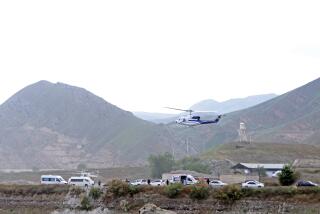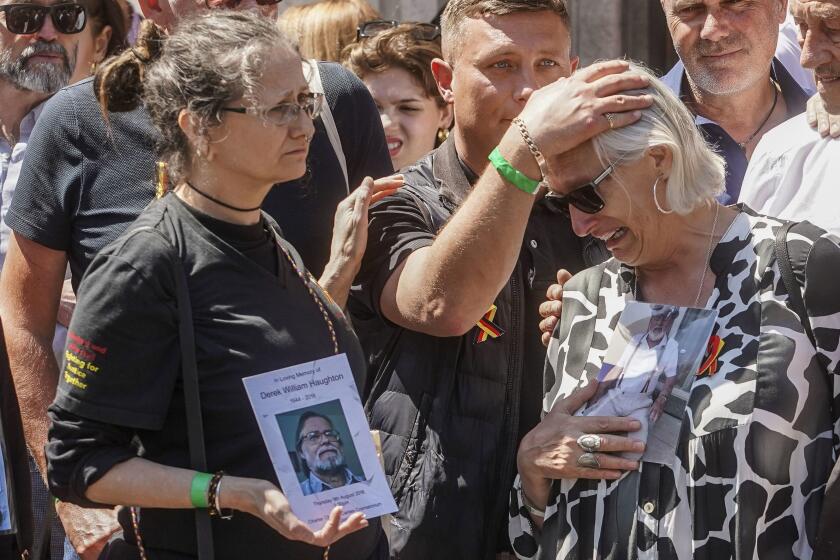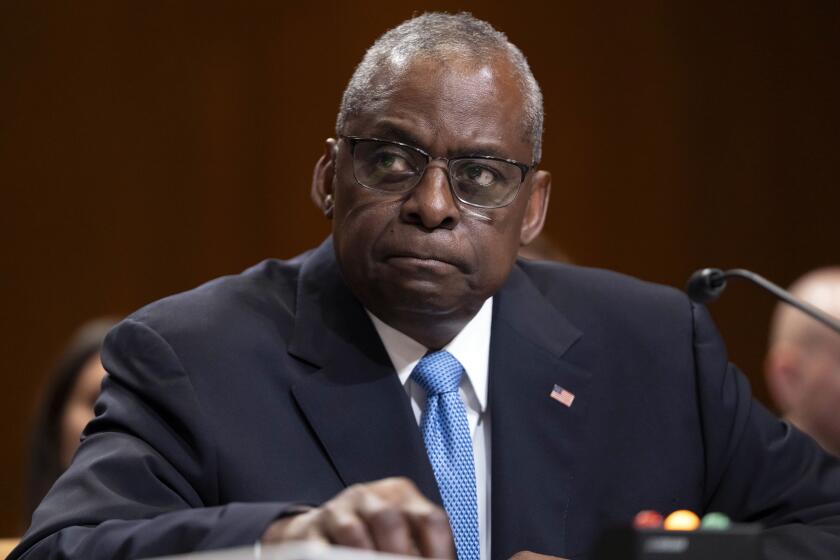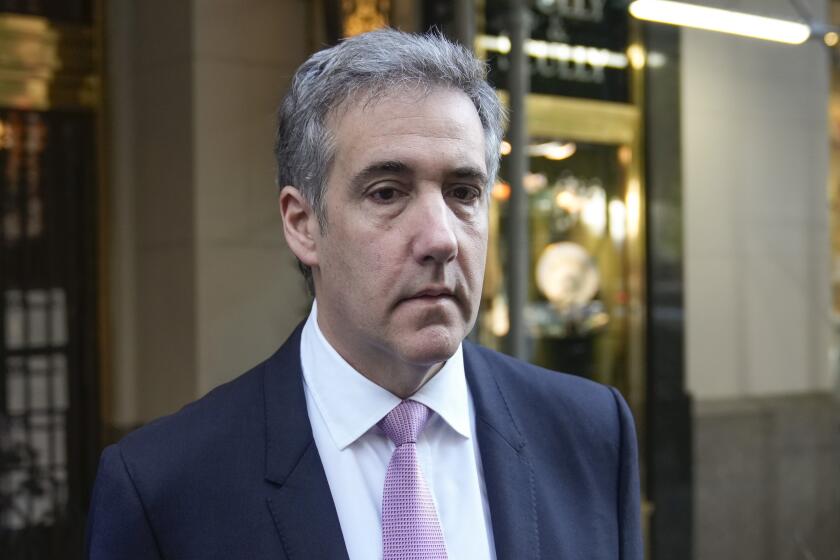COLUMN ONE : Rebuilding Eyes, Limbs--and Lives : New medical techniques and Oklahoma City’s sophisticated health care system are helping injured blast survivors recover.
Susan Walton had stopped by her credit union in the Murrah federal office building on that spring morning to make a quick deposit before going to school. Martin Cash was reading a paper in his office at the VA. Steve Pruitt was filling out a travel voucher on the third floor. And Daina Bradley had stopped by with her family to pick up a Social Security card for her 4-month-old son.
At 9:04 a.m. on April 19, their lives changed forever when a terrorist bomb exploded, destroying nearly half the Alfred P. Murrah Federal Building, killing 167 people and injuring more than 500.
Walton had a badly broken jaw, a ruptured spleen and crushed legs. Cash lost an eye. Pruitt was blinded in one eye. And Bradley lost a leg.
All are recovering surprisingly well, thanks both to this city’s sophisticated medical system and to several medical techniques developed in the last decade.
That sophistication is a legacy of the 1970s oil boom, which provided funds not only for new buildings and equipment, but also to attract leading doctors from around the country. As a result of that legacy--and a remarkable degree of good fortune--physicians said, relatively few people suffered permanently disabling injuries in the ferocious blast.
Only four people who were brought out of the building alive died later and a handful suffered serious disfigurement--one had a limb amputated and several lost eyes.
If the bombing had to happen, said Dr. M. Alexander Jacocks, chief of staff at the University of Oklahoma’s University Hospital, the timing and location increased the victims chances of survival: it was early in the morning, in the middle of the week, and less than a mile from four major hospitals with excellent facilities.
New medical technologies--several developed locally--also are helping the survivors, including surgical techniques, eye implants and prosthetic limbs. “We’re doing things that couldn’t be done 10 years ago,” said Dr. N. Robert Markowitz, a surgeon at the University of Oklahoma Health Science Center.
The experiences with the survivors show that “you don’t have to be in Los Angeles or New York to get high-quality medical care,” Jacocks said.
*
Every physician within at least 15 miles of the Murrah building heard and felt the explosion and could see the dense black smoke rising from the site. Emergency plans were quickly activated.
Hospitals everywhere routinely practice for such disasters, often twice a year. “The average physician doesn’t pay much attention to those practices,” Jacocks said. “But having a plan in mind proved to be extremely helpful.”
The bombing set off a medical emergency response that, thanks to those routine practices, was immediate and comprehensive.
All non-emergency surgeries at the four hospitals nearest to the blast--University, Presbyterian, St. Anthony’s and Children’s--were canceled. Waiting patients were sent home and hospitalized patients who could be discharged were. Physicians of all specialties congregated in the emergency rooms to help--so many, in fact, that most victims were seen by several at once.
It was not uncommon for as many as four surgeons to operate on one patient simultaneously. One surgeon might deal with internal injuries while another repaired facial lacerations and two others handled limb injuries. In this fashion, time under anesthesia was minimized and injuries were treated as quickly as possible.
Although some operations continued into the late evening, the emergency rooms where victims were received were largely empty by 4 p.m. There was “a big emotional letdown” among the ER crews when it became apparent that all the survivors had reached the hospital and that everybody else was dead, said Dr. Thomas Lera, chief of staff at Children’s Hospital of Oklahoma. “We were devastated when there was no second wave of survivors,” Jacocks added.
Most of the hospitalized victims recovered quickly and were released within 10 days. The last patient was released Wednesday.
Among the most common injuries were lacerations from pieces of large plate-glass windows, which flew through the air like shrapnel. The cuts “were like you see in a severe auto accident or bus wreck,” said Dr. Hal D. Balyeat of the Dean A. McGee Eye Institute.
Balyeat and his colleagues at Presbyterian Hospital treated four survivors with severe eye injuries. Three lost an eye and one has limited vision. A similar number were treated at other hospitals, he said.
Rebuilding a Face
One beneficiary of the new surgical technologies was Steve Pruitt, a 32-year-old General Accounting Office employee who had been filing paperwork to be reimbursed for a trip. “I don’t remember the explosion,” he said. “All I remember is waking up and wondering, ‘Why am I sleeping at work?’ ”
Pruitt was blown 25 feet through the air, landing just two feet shy of the edge of the collapsed building. The bony socket around his left eye was crushed, the eyeball was ruptured, his nose and jaw were broken and he had cuts all over his body that have not yet healed. His right contact lens was shattered and had to be surgically removed. He spent 10 days in the hospital.
Shortly after Pruitt was admitted, Markowitz began the meticulous series of rebuilding procedures. The surgeon made a broad incision inside his mouth, peeled back the skin of the face and repaired the jaw and the socket around the eye. Rather than wiring Pruitt’s jaw shut while it healed, as surgeons once did, Markowitz used microtitanium plates to hold it together. These small metal plates are screwed into the bone on each side of the break. “That’s a big plus for recovery because the patients can eat better,” he said.
In a subsequent surgery, Dr. P. Lloyd Hildebrand of the McGee Institute used a laser to reattach the retina in Pruitt’s left eye and filled it with synthetic aqueous humor. Pruitt now can see light and dark and shapes, but his vision in that eye is extremely limited.
His future is up in the air. Before the bombing, he had been accepted for training as an FBI agent. Only a minor snafu kept him from being at the training site in Quantico, Va., when the explosion occurred. FBI regulations require that a prospective agent have sight in both eyes, he said, “but there’s a good chance they’ll give me a waiver because of the circumstances.”
Rebuilding an Eye
Martin Cash, 52, lost his left eye when it was pierced by two large pieces of glass. “I saw a red flash and thought, ‘My God, I’m having a stroke,’ ” he said. He pulled out one of the pieces of glass, about 1 1/2 inches long and shaped like an icicle, himself. “There wasn’t that much pain,” he said. “The body is wonderful when you go into shock.”
Hildebrand used new technology to replace the eye. Once the bone around it had been repaired, he inserted a new type of prosthesis made of hydroxyapatite, a porous mineral similar to that found in coral. The prosthesis prevents the tissue around the eye from collapsing and producing a sunken, emaciated appearance.
Until the late 1980s, metal or glass eyes were used as prostheses, but they would roll around in the socket and often would pop out. Muscles and blood vessels attach to and grow into the hydroxyapatite, however, so that the prosthesis mimics the motions of the healthy eye. “We try to reconstruct it as naturally as possible,” Hildebrand said.
Two weeks ago, ocularist Henry LaFuente covered the prosthesis with a thin piece of plastic, shaped like a contact lens, painted to match Cash’s other eye. After another six months or so of healing, Hildebrand will insert a peg into the prosthesis and attach the artificial eye permanently so that it moves in concert with the prosthesis, better matching movements of the healthy eye. “It’s able to make the quick, darting movements that you normally see in conversation,” he said.
Cash, like some others, is still removing small pieces of glass from his good eye as they work their way to the surface. So far, more than 100 pieces have emerged. Meanwhile, he plans to retire from the VA and pursue a new career: “God has something planned for me, but I just don’t know what it is yet.”
Hildebrand cautions that all of the survivors who suffered eye damage are at higher risk of developing further problems, including cataracts, detached retinas and glaucoma, because of changes in eye structure. “They are ophthalmic patients for life.”
Cash and other survivors are also trying out another innovation, an acrylic mask developed by LaFuente to reduce scarring. The mask is molded from a sculpture of the desired facial appearance, then held in place for several hours each day with Velcro strips that fasten around the head. The mask, LaFuente says, softens scar tissue and forces it to migrate below the surface of the skin, where it is not as apparent.
LaFuente had begun a clinical trial of the masks on 40 patients seven months before the bombing and decided to extend the trial to survivors who wished to use it rather than undergo plastic surgery. He had found in the earlier trials that its use could reduce scarring caused by adult-onset acne and other conditions and could control further eruptions of acne without antibiotics.
If the masks do not work well with the survivors, the local association of plastic surgeons has volunteered to repair scarring. (All the physicians and hospitals treating survivors are charging only whatever a patient’s insurance will pay.)
Replacing a Lost Leg
Bombings are normally associated with lost limbs. But experts speculate that this blast was so strong that those directly exposed were mutilated so badly that they were killed outright. The others were either shielded or far enough away.
The only survivor who is known to have lost a limb is 20-year-old Daina Bradley, whose right leg was amputated with a pocket knife by Dr. Andrew Sullivan of University Hospital to free her from debris. Her son, 3-year-old daughter and her mother died in the explosion. Her sister lost an ear.
Bradley has already been fitted with a temporary prosthesis by Oklahoma City-based Novacare Sabolich Prosthetic Center, one of the largest prosthetic manufacturers in the world. “Normally, we wouldn’t fit one this soon, but she had gone through so much that she needed a lift,” said Carol Sorrels, a Sabolich spokeswoman.
The Sabolich leg uses a recently patented contoured cup to support the leg. On most prostheses, the cup is shaped like a rounded rectangle. “It’s like trying to fit a round peg into a square hole,” said John Sabolich, the developer. The contoured cup provides better support, is more comfortable and reduces rubbing and blistering, he said.
Sabolich is in the midst of a clinical trial of new prostheses that allow the wearer to sense pressure, heat and cold. Sensors on the foot transmit information to a 9-volt battery-sized microcomputer that converts the pressure information into a “tingling” conveyed by discs surrounding the stump. Heat and cold are conveyed by another disc that responds rapidly to temperature changes.
Bradley’s prosthesis has already been equipped with a pressure sensor and is being fitted with the temperature sensor.
The pressure sensor improves balance and the ability to walk, Sabolich said, and the sensations provided to the stump eliminate as much as 90% of the “phantom pain” generally associated with a lost limb.
Bradley will be fitted with a series of stripped-down legs over the next six months as the swelling subsides. Ultimately, she will receive an artificial leg that closely matches her own skin tone, down to freckles and veins. Sabolich has offered to donate a similar prosthesis to any other survivor who needs one.
Rebuilding a Jaw
One of the more seriously injured was Susan Walton, a 44-year-old accountant and college student who was making a deposit at the credit union to pay her taxes. Walton’s jaw was injured so badly--six breaks compared to the two most people suffer when their jaw is broken--that she could not talk. This led to a bizarre misunderstanding when Walton--who is studying sign language in college--attempted to use signing to identify herself.
Physicians first thought she was flailing about as a result of brain damage and restrained her. Not until about 7 p.m. did anyone recognize the gestures and summon an interpreter, who was able to help her identify herself.
In addition to the broken legs, nose and jaw, Walton had massive internal injuries. “I was a real mess,” she says today with a smile provided by painstaking surgery.
Putting her jaw back together was not an easy task, Markowitz said, because it was broken in so many pieces that it was not obvious how they fit together. She was also missing eight teeth. He used a relatively new technique, making molds of her remaining teeth and analyzing their wear to determine where they belonged in her mouth.
After hours of study, he made a plastic retainer for the teeth. When he put it on her, all the parts of the jaw lined up properly and he rejoined them with microtitanium plates. “The key is in restoring the proper bite,” he said.
Walton’s legs were a more serious problem. “Her right knee joint just exploded into 12 to 15 pieces,” said Dr. Michael O. Williams of Orthopedic Associates. To put it together, he resorted to the Ilizarov method, developed in the Soviet Union in the 1950s, but imported to this country only in the last decade.
The Ilizarov apparatus is a tube-shaped series of metal rings, linked firmly by steel rods, that surround the leg. From them, very thin wires are threaded through the bone like the spokes of a bicycle wheel to hold the bone in position.
The wires used in the device have a small ball machined onto them so that, when the wire is threaded through a piece of bone, the ball catches and holds the bone. “We spear a fragment with the wire and pull on it to pull the fragment where we want it. And we do it with minimal incisions so that it heals faster,” Williams said. Walton’s right leg has 32 wires holding it in position.
Her left leg presented a different problem because the talus bone on the top of her foot “fell out on the operating table,” Williams said, leaving a three-inch gap between her leg and her foot. A slightly different form of the Ilizarov apparatus was used, in effect, to stretch the bone by as much as one millimeter per day. Already, it has grown an inch. Once the bone is long enough so that her legs are of equal length, it will be fused to her foot. There are 34 wires piercing this leg.
Walton’s right leg will remain in the device for six more months, while the left one will require 16 to 18 months to heal.
In another couple of months, Williams will insert hinges so that Walton’s legs can bend at the knees. She is looking forward to that.
“There aren’t many places you can go when your legs are sticking straight out in front of you,” she said.
More to Read
Start your day right
Sign up for Essential California for news, features and recommendations from the L.A. Times and beyond in your inbox six days a week.
You may occasionally receive promotional content from the Los Angeles Times.






